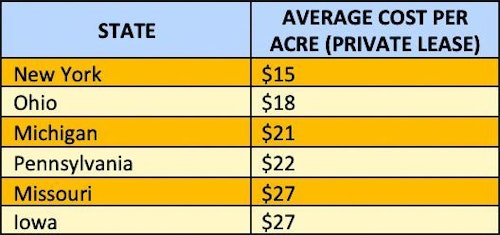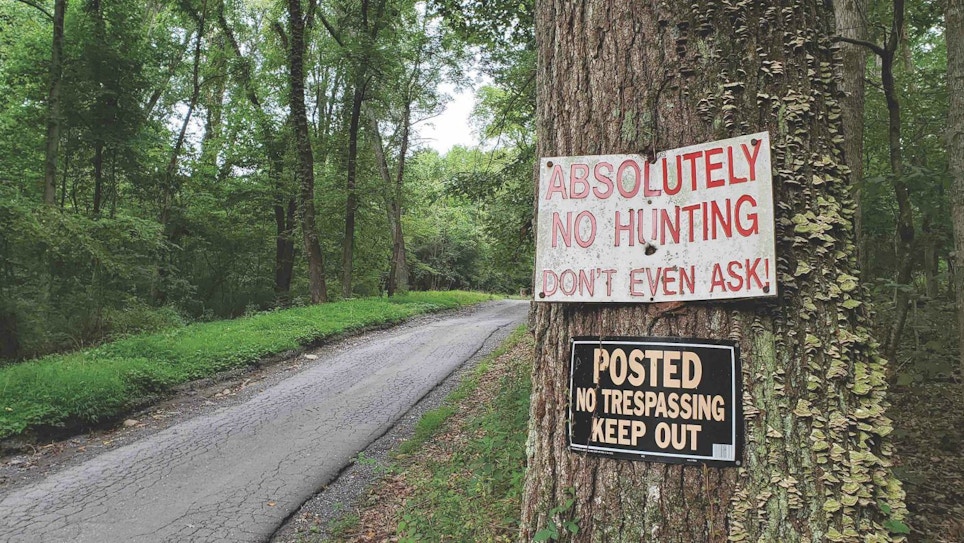The ad — near my southern Pennsylvania home — read, “$3,200 for 68 acres of mostly planted corn. Up to four hunters. It is a great location to see some deer.”
Quite frankly, my goal isn’t to “see some deer.” Rather, as a deer hunter, my goal is to fill my tag and have venison readily available for my pellet grill. In Pennsylvania, I get one buck tag and potentially one doe tag — if I get my application in early enough. Plus, 68 acres is too crowded for four hunters. In fact, according to the new QDMA density map, southern Pennsylvania has anywhere from 15 to 30 deer per square mile. Even if you assume 30 deer per square mile there, that equates to only three deer living on that small acreage. How many years of $3,200 will four hunters spend before filling a tag on a mature buck? Your guess is as good as mine.
Let’s face it, leasing hunting land is expensive, and often you don’t receive what you pay for. Are other options available?
Public Land Option
Personally, I cannot afford a 300-acre lease, so in the past I spent the majority of my time hunting public land. I absolutely loved hunting public land. I was always up for a challenge and loved nothing more than to go in a new area looking to harvest a mature whitetail deer. Success was rewarding.
However, for me, this style of hunting ultimately came with a different price tag. Time away from my family, long hours afield, a great deal of sweat with nothing short of hard work and dedication to show for it. Because I hunted hard, those were my costs when I hunted public land. You seldom found me stepping foot on public land to hunt when I only “had a few hours to hunt.” My public land hunts required hours of map reading, a good pair of boots and consecutive days committed to the hunt. Getting far off the beaten path was what helped fill my tag on public lands annually.
Hunting public land didn’t not always produce the results I was looking for. I was always in search of a better opportunity. Likewise, trying to find private ground to hunt proved just as difficult. Through my searches, however, I found other options.
Getting Into Deer Management
Several years ago, I dated a girl who had an uncle who owned a farm. In his driveway he had a sign that still hangs today that read, “NO HUNTING. DON’T EVEN ASK.” As luck would have it though, he was not a hunter but did allow a few selected individuals to hunt his farm. He hates having deer on his property so much that he and his father have offered to pay the select group of hunters $20 for every deer killed there. They refer to the deer as “land rats,” and those land rats are eating away their profits every year. Luckily, I too became one of the few hunters in the group.
When I first started hunting there I saw tons of deer. One evening, I found it quite entertaining to sit and see well over 20 deer in the field. These were not just does either, there were plenty of 120-inch-plus bucks running the property. It was here I really started to learn how whitetail deer live. I spent the next several years hunting, observing and learning deer behavior, but kept one thing in mind: The farmer wanted me there to kill deer.
At the time, in Montgomery County, Maryland, you could shoot an unlimited number of does and up to four bucks a year. This made for a great season, helping the farmer out while at the same time filling up my freezer. My target was mature does and nothing under a 3.5-year-old buck. I started shooting a lot of deer, and even though I had been doing this, the deer numbers stayed strong year after year. It was after five years of hunting on this particular farm that I found out he leased land to farm across the street that also had high deer densities. Then I learned that farm had contracted a hunting management team to help solve its deer problems.

Everything Comes at a Price
As I mentioned before, hunting leases are expensive and public land hunting costs time. This hunting management team, however, didn’t really have much of a cost. I knew I had to join and that’s exactly what I did. The cost was the small membership fee of $200.
The trade-off for hunting the managed land was a focus on mature does. There were also strict rules to follow, especially in suburban areas. But at the end of the day, I had access to great hunting properties and a chance to really watch and learn deer behavior evolve throughout the season.
I actually grew so infatuated with this group, I ended up becoming the team manager after Matt Dye left to create Land and Legacy — a land and wildlife consulting company. What I didn’t really know though was how much work was required. I found myself organizing hunts, conducting interviews, holding meetings with both local and state officials, keeping constant communication with directors of the Department of Natural Resources, managing all of the hunters and collecting data nonstop. As a volunteer, I wasn’t sure the work was worth my time.
Creating a Deer Management Team
Timing is everything, and it just so happened the owner of the whitetail deer management company no longer wanted to deal with it. After several meetings with the owner, I took over, forming my own brand. I formed an LLC to protect myself and members from any liability issues, had a logo created and built a website.
From there, it was a matter of acquiring solid groups of hunters and establishing strong rules and regulations. For me, this was quite simple because I was able to assume all of the original accounts, as well as the existing hunters. To grow the business and membership, I spent a few marketing dollars, as well as conducted interviews and background checks to ensure I was bringing on the right people. Now, our roster is set at 20 hunters, all with years of experience. This group is a company, not a big buck hunting club. Most importantly, our members are trustworthy, follow the rules and have zero hunting violations.
To finalize the operation, I turned to handling shooting qualifications, background checks, safety meetings and, of course ,obtaining hunting insurance. I had a reputation to uphold, and my recipe for success was running my company in a professional manner. The initial cost for the LLC, logo, website, insurance and domain name was roughly $1,200. I then created an annual budget that pays me anywhere from $3,500-$4,000 a year for my work, which comes from the membership fees of $500 per member. The additional funding goes to overhead costs and property leasing.

How to Acquire Properties
With the original 900-acre farm, a 240-acre private farm, and a 600-acre HOA property that I had acquired on my own, as well as an additional county park of 600 acres, I now had access to 2,340 acres of private land in an area where deer densities are over 45 deer per square mile. All the members have this same access for just $500 a year. This surely beats that 64 acre lease for $3,200.
To gain and grow your properties, there are a few options readily available. Development land owners are always great clients as they look to build on their land. Home owners associations are always great to work with, especially in the suburban areas where deer will destroy expensive shrubbery and gardens as well as cause a substantial amount of vehicle collisions annually. Recycling and waste management companies are also optimal clients, as they will purchase hundreds of acres of land with potential to expand. In the meantime, they’ll lease that land out to local farmers. Ultimately, that land is no good to the farmers if there is an abundance of deer on the property ruining their crop.
There will always be places, especially within 50 miles of major metropolitan areas, that will flat out have too many deer. Starting a deer management company is a great way to get access to thousands of acres of prime hunting land, and it may only be just a couple hour drive from your house.

Keys to Success
To make your company stand out, the key is to present yourself as a business, not a hunting club. You have to remember you are there to provide a service and follow through. Establishing rules for hunters to harvest a certain number of does before they can shoot a buck is one tool that helps keep that focus. Another option, and I use this in addition to the doe requirement, is to have buck restrictions by age and size. On some properties, I allow a 2.5-year-old to be harvested, and some must be a 3.5 or older with a 140-inch or greater gross score. Having these requirements can keep your team in focus with the mission of the business and provide a positive service for your clients.
Additionally, having zero hunting violations is also a critical component. I strongly recommend having hunters’ insurance and showing that there is no liability on the land owner. Included with insurance are things like requiring your hunters to always use a safety harness. Additionally, I recommend requiring shooting qualifications for all weapons, both archery and firearms. Have a quiz or test to ensure hunters can identify the age structure of both bucks and does. This, along with penalty fees, ensure hunters shoot only the correct deer.
At the end of the day, anyone can start up a management company. To be successful, having a great relationship with your clients and keeping your hunters in check will separate you from similar groups in your area. If you would like to add a few more tags to your pocket each year, form a whitetail deer management team today.

Sidebar: 4 Tips for Buying a Whitetail Property
Are you interested in buying a property to share and hunt whitetails? If so, Whitetail Properties Mississippi Land Specialist Chipper Gibbes offers these four tips.
1. Large Enough
Ensure the property is big enough for the number of hunters you intend to have as members. Quality deer management is much more attainable on larger land tract; most share/hunt clubs range in size from 4,000 to 10,000 acres. Obviously, properties of this size are an enormous financial obligation. However, if several individuals pool their financial resources to form a club, individuals can take part in, and benefit from, large property ownership.
2. Hire a Professional
Anyone wanting to set up a share/hunt club needs to align themselves with a good attorney and a good banker, each with experience and familiarity with hunting clubs and membership. If organized appropriately from a legal standpoint, these shares can be bought, sold and mortgaged.
3. Consult a Land Broker
Prior to making a purchase, consult with an experienced land broker to hash out the specifics of a purchase, such as member guest regulations, buck harvest criteria, long-term timber management plan, annual dues, by-laws and other rules and regulations. Rules and regulations can make or break the appeal of share/hunt clubs memberships.
4. Understand the Challenges
Keep in mind, that share/hunt clubs have a different dynamic. The selling process can be considerably more complex and challenging than simply selling a piece of land to a single buyer. Not only do you have to sell the property to the buyer, you have to sell the rules, regulations and the existing members to the new member. Likewise, you have to sell the new member to the existing members.






